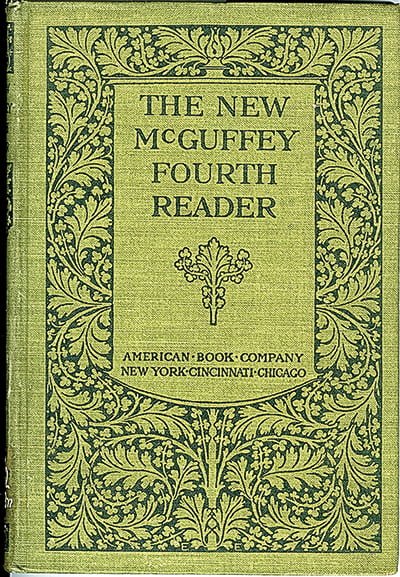
Laura Dean Bennett
Contributing Writer
Old McGuffey Readers are highly collect-ible antiques these days, but as old-fashioned as many people might assume them to be, they stand today as one of the first and one might say, most successful American educational systems ever conceived.
Whether your grandparents or great-grandparents went to school in a one room schoolhouse, were home-schooled or attended a village school, it’s likely that they were familiar with McGuffey Readers.
Many generations of American school children were raised on them and have them to thank for a strong foundation that prepared them for advanced education and living a good life.
During the 17th century, the first textbooks in the American colonies were primers borrowed from our cousins across “the pond,” as they were brought over from England.
By 1690, Boston publishers were reprinting the English Protestant Tutor as an Americanized version, called The New England Primer.
It is estimated that at least 120 million copies of McGuffey Readers were sold between 1836 and 1960, placing its sales right up there with the Bible and Webster’s Dictionary.

The England Primer was widely distributed in colonial schools until the “blue backed speller” of Noah Webster came along.
Webster’s “speller” was the most common textbook in America from the 1790s, that is, until the first McGuffey Reader came along and was an instant success.
The McGuffey Reader was first published in 1836 by William Holmes McGuffey.
McGuffey was born in 1800 in Pennsylvania to a staunchly religious family of Scottish immigrants.
His family had immigrated to America from Scotland in 1774, and brought with them their strong opinions on religion, hard work and a fervent belief in education.
McGuffey’s early education began in the family’s log cabin, where his mother taught her children “the three Rs.”
Local subscription schools, generally taught by a young man or a minister, provided further education.
Like Abraham Lincoln in western Kentucky amid similar wilderness conditions, young McGuffey borrowed books from neighbors, memorized portions of the Bible and sermons, read before the fireplace, and taught his younger brothers and sisters at home.
Educating the young people and preaching the gospel were McGuffey’s passions.
He had an amazing ability to memorize, and memorized most of the books of the Bible.
His father crafted an adjustable wooden candle stand to provide better light for his reading.
In 1814, before his 14th birthday, “Master McGuffey” opened his own school at West Union (now Calcutta), Ohio. Thus began his professional teaching career in a one room schoolhouse with 48 students who paid two dollars each for his instruction.
The size of the class was just one of several challenges faced by the young teacher.
In many one-teacher schools, children’s ages varied from six to twenty-one.
Like many frontier teachers back in those days, McGuffey often worked 11 hours a day, six days a week in a succession of schools, mostly in Kentucky.
Few students had any books to bring to school for reading practice, and since few textbooks were available, many brought their family bible.
Between teaching assignments, McGuffey received a classical education at the Old Stone Academy in Darlington, Pennsylvania, and graduated from Washington College in 1826.
That same year he was appointed to a position as Professor of Languages at Miami University in Oxford, Ohio.
In 1827, McGuffey married Harriet Spinning, and the couple had five children.
While McGuffey was teaching at Oxford, he established a reputation as a lecturer on moral and biblical subjects.
In 1835, his friend, Harriet Beecher Stowe, recommended McGuffey to a small Cincinnati publishing company, Truman and Smith, as the right person to create a series of four readers for primary level students.
He completed the first two readers within a year of signing his contract, receiving a fee of $1,000.
McGuffey was offered a professorship in languages at Woodward College in Cincinnati.
He studied law at the Cincinnati Law School and was admitted to the Ohio bar as a lawyer in 1839.
While McGuffey compiled the first four Readers (the 1836-1837 edition), the fifth and sixth were created by his brother, Alexander McGuffey during the 1840s.
The series consisted of stories, poems, essays and speeches.
The advanced readers contained excerpts from the classic works of great writers such as John Milton, Daniel Webster and Lord Byron.
McGuffey readers became the standard textbooks in one room school houses across the country, from 1836 well into the 20th Century, with tens of millions of copies sold nationwide.
Children were taught according to their ability, not their age. A student moved on to the next reader when they had mastered all the material in their previous reader.
Teachers taught the subject as long as the subject needed to be taught. They were expected to identify the strengths and weaknesses of their students and tailor lessons to each individual student.
McGuffey Readers were not only in the established schoolhouses of every state in the Union, but the readers were also the constant companions of millions of children as they made their way West in covered wagons with their brave families.
Between 1836 and 1890 alone, McGuffey’s publisher printed and sold more than one hundred million copies of McGuffey’s Reader.
Practically every American who attended public schools during the second half of the 19th Century learned not only how to read and write, but learned foundational ethical lessons from their McGuffey Readers.
After the Civil War, they were the standard textbooks in schoolhouses in 37 states.
McGuffey believed it unwise to begin a child’s formal education at too young an age.
Unlike many educators of his time, McGuffey believed in adapting the learning process to each student’s ability and interests. As no two children are alike, he believed that each student should be treated accordingly.
But, like most educators of the period, McGuffey was a fan of “rote learning” (memorization).
He was a staunch Christian and believed firmly in the principles of morality as presented in the Bible and used it as the foundation of much of his method.
His readers were more than a series of textbooks – they helped frame the country’s morals and tastes, and helped shape the American character.
The lessons in the readers encouraged high standards for civilized society throughout the United States for more than a century.
While improving students’ spelling and sharpening students’ vocabulary, the readers also helped youngsters develop the art of public speaking.
In the 19th Century, elocution played an integral part in public life, and McGuffey was undoubtedly responsible for creating a generation of gifted orators and readers.
The McGuffey Readers encouraged children’s natural curiosity and placed a high value on allegiance to country and religious values.
They were chock full of lively stories of the importance of truthfulness, character and goodness, touching on such topics as lying, stealing, cheating, poverty, teasing, alcohol, overeating, skipping school and foul language.
Late in the 20th Century, McGuffey Readers became quite collectible.
Since 1961 they have continued to sell at a rate of some 30,000 copies a year. No other textbook bearing a single person’s name has come close to that mark.
McGuffey Readers are still in use today in some school systems, and by parents for home-schooling purposes.
Even today, in the early 21st Century, there is still a population of loyal McGuffey followers.
The textbooks have been edited and updated throughout the years to be available to mostly home-schooled students and Christian academies.
The latest version of the series was printed in 2010 and published by both General Books and Applewood Books.
There are also McGuffey Readers on eAudiobooks, produced by Mission Audio in 2010.
The basic alphabetical rules of writing and reading strategies for novice readers have been preserved in updated versions of the readers and now, “ there’s an app for that!”
Modern moms and dads can now buy McGuffey Readers on iTunes.
The McGuffey app is called, “Phonics and Reading” and it offers a modern reading primer based on the original McGuffey readers.
For anyone who enjoys a good read, whether a child or adult, I heartily recommend McGuffey Readers. Some things never change, and I firmly believe that the love of good literature will always be part of the American tradition.



